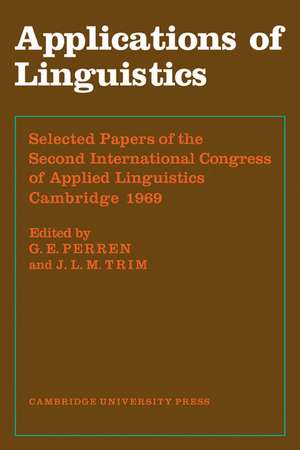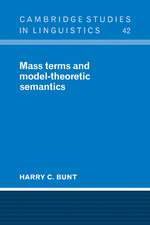Applications of Linguistics
Editat de G. E. Perren, J. L. M. Trimen Limba Engleză Paperback – 17 feb 2010
Preț: 363.28 lei
Nou
Puncte Express: 545
Preț estimativ în valută:
69.51€ • 72.76$ • 57.86£
69.51€ • 72.76$ • 57.86£
Carte tipărită la comandă
Livrare economică 31 martie-14 aprilie
Preluare comenzi: 021 569.72.76
Specificații
ISBN-13: 9780521131414
ISBN-10: 0521131413
Pagini: 520
Dimensiuni: 152 x 229 x 29 mm
Greutate: 0.75 kg
Editura: Cambridge University Press
Colecția Cambridge University Press
Locul publicării:Cambridge, United Kingdom
ISBN-10: 0521131413
Pagini: 520
Dimensiuni: 152 x 229 x 29 mm
Greutate: 0.75 kg
Editura: Cambridge University Press
Colecția Cambridge University Press
Locul publicării:Cambridge, United Kingdom
Cuprins
Foreword; Editors' introduction; Part I. Papers from Plenary Sessions: 1. Applications of linguistics; 2. The uses of sociolinguistics; 3. Technological development for language learning; 4. Applied computational linguistics; 5. La neurolinguistique; 6. Linguistic factors in communications engineering; Part II. Papers from Specialist Sections: 7. Language and attitudes of the Spanish-speaking youth of the Southwestern United States; 8. Some comparative descriptions of children's language; 9. Cross-level interference: the influence of L1 syllable structure on L2 morphological error; 10. Some psycholinquistic considerations involved in a language-testing project; 11. A suggested rationale for the treatment of developmental disorders of language; 12. Language testing in the primary school; 13. The Radio Brighton pilot project: an experiment in teaching languages by radio and telephone; 14. The reliability of the essay subtest in a university entrance test in English for non-native speakers of English; 15. Tensions of television course-writing; 16. Aptitude for and proficiency in French in the first year of the UK secondary school; 17. Linguistic observations on the heroic couplet in English poetry; 18. The use of the Dvanagari script as a phonemic notation for the teaching of English pronounciation in North India; 19. Analyse électronique de textes litteraires appliquée à la lexicographie en Italie; 20. Bruit et perception auditive (étude experimentale); 21. Applications of behavioural technology: from conventional lab teaching to technological total self-instruction; 22. Distinctive features and phonetic dimensions; 23. Learning and re-learning articulartory skills; 24. Grammaires d'enfants agrammatiques; 25. An error analysis in German of first-year university students; 26. Analysis of decoding impairments in dysaphasic subjects; 27. Three experiments in the use of VTR in language teaching; 28. Children's use of categorisation in remembering verbal material; 29. Teaching syntactic maturity; 30. Preliminary recommendations of the Swedish research project on language laboratories in university teaching: an interim report; 31. Some temporal factors in the listening behaviour of second language students; 32. Static and dynamic lexical systems; 33. A quantitative theory of cardinal vowels and the teaching of pronounciation; 34. L'apport de la radio dans l'enseignement du français à l'école primaire sénégalaise; 35. Contrastive analysis of the Hungarian and Serbocroation noun phrase; 36. Semantic components in translation theory; 37. Language varieties along the US-Mexican border; 38. Talking to some purpose (choosing the language-teaching points of the Nuffield/Schools Council German course; 39. Limites des applications de la linguistique à la lexicographie; 40. A new concept of the language laboratory and its application to research and the development of proficiency in language learning; 41. Reduced redundancy as a language testing tool; 42. A recent development in English language educaiton in Japan: materials analysis; 43. Where has all the money gone? The need for cost-effectiveness studies in the teaching of foreign langauge; 44. Language development programs for Southern American Negroes; Un cours de français télévisé et son évaluation; 46. Teaching standard English to speakers of other dialects; 47. CARLOS: computer-assisted instructions in Spanish; 48. Productive communication testing: progress report; 49. Lexical density and register differentiation; 50. Une solution au problème des homographes du français moderne; 51. Research in applied linguistics and its impact upon foreign language teaching materials; 52. Language deprivation and remedial teaching techniques; Appendices.
Descriere
The Second International Congress of Applied Linguistics of 1969, provided scholarly papers from all over the world on applied linguistics.





















